Create Github pull request
This example illustrates how to open a pull-request in a GitHub repository from within Port using a Jenkins pipeline.
The workflow involves adding a resource block to a Terraform main.tf file and subsequently generating a PR for the modification on GitHub. In this specific instance, the added resource is a storage account in the Azure cloud.
- This guide assumes you have a Port account and a basic knowledge of working with Port. If you haven't done so, go ahead and complete the quickstart. Setup the
Serviceblueprint that you will be using in this guide. - You will need a GitHub repository in which you can place the files that we will use in this guide. If you don't have one, we recommend creating a new repository named
port-actions. - Generic Webhook Trigger - This plugin enables Jenkins to receive and trigger jobs based on incoming HTTP requests, extracting data from JSON or XML payloads and making it available as variables.
Example - modify main.tf to add a resource block
Setup the action's frontend
-
Head to the Self-service tab in your Port application, and click on
+ New action. -
Each action in Port is directly tied to a blueprint. Our action creates a resource that is associated with a service and will be provisioned as part of the service's CD process.
Choose
Servicefrom the dropdown list. -
This action does not create/delete entities, but rather performs an operation on an existing entity. Therefore, we will choose
Day-2as the action type.
Fill out the form like this and clickNext:
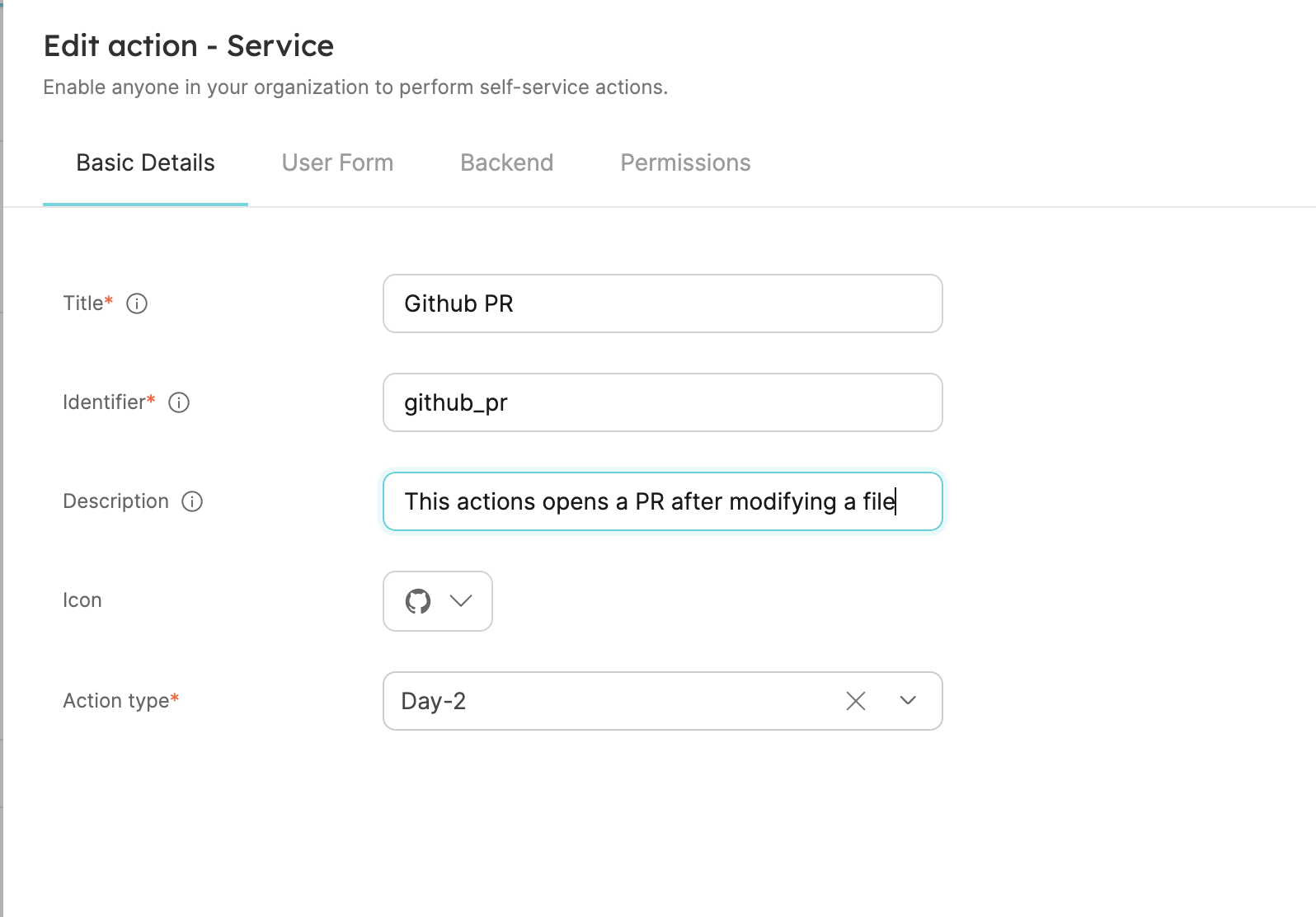
- We want the developer who uses this action to specify simple inputs and not be overwhelmed with all the configurations available for an Azure storage account. For this action, we will define a name and a location.
Click on+ New input, fill out the form like this and clickCreate:
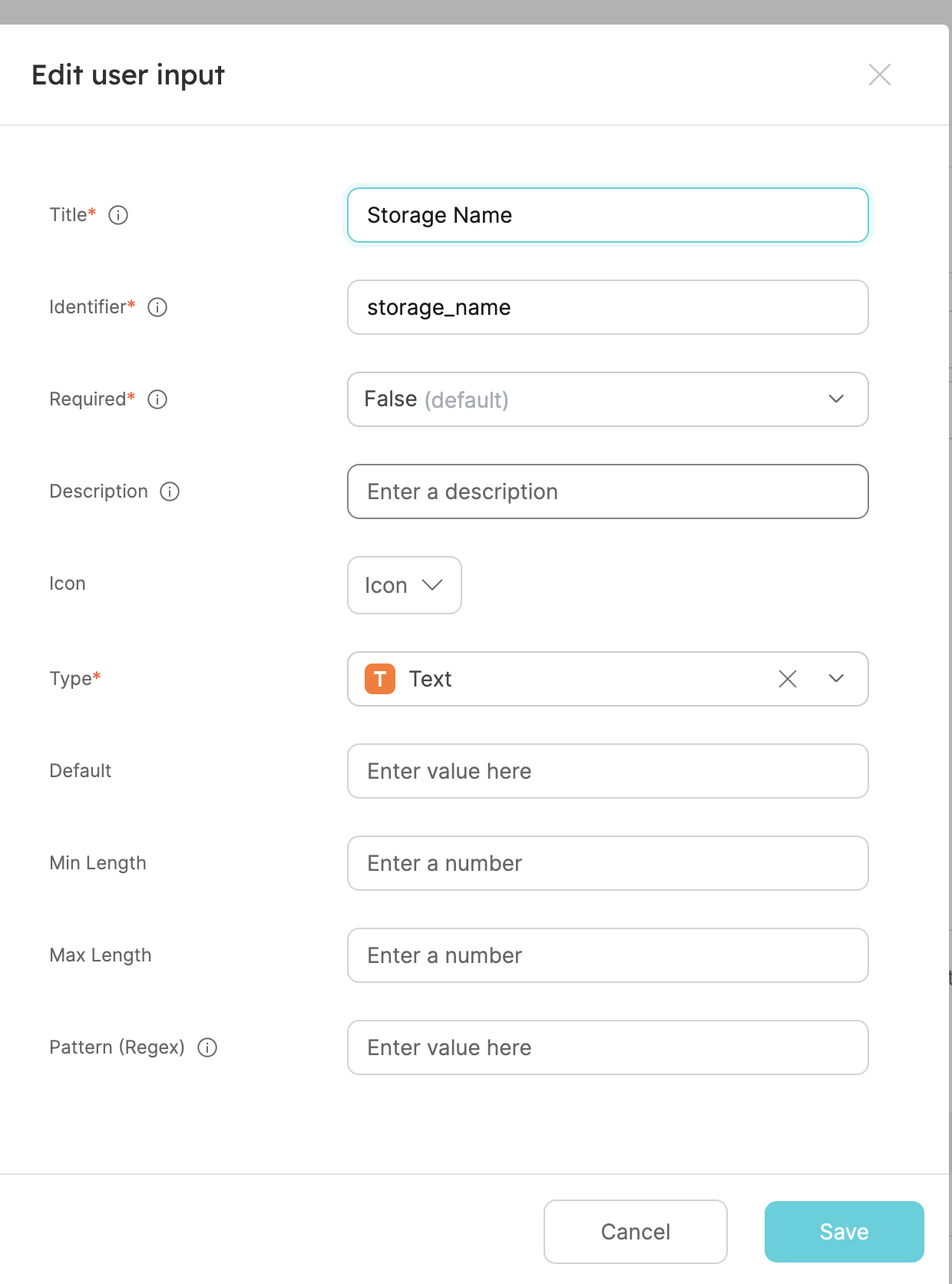
- Now let's create the location input of our resource.
Click on+ New input, fill out the form like this and clickCreate:
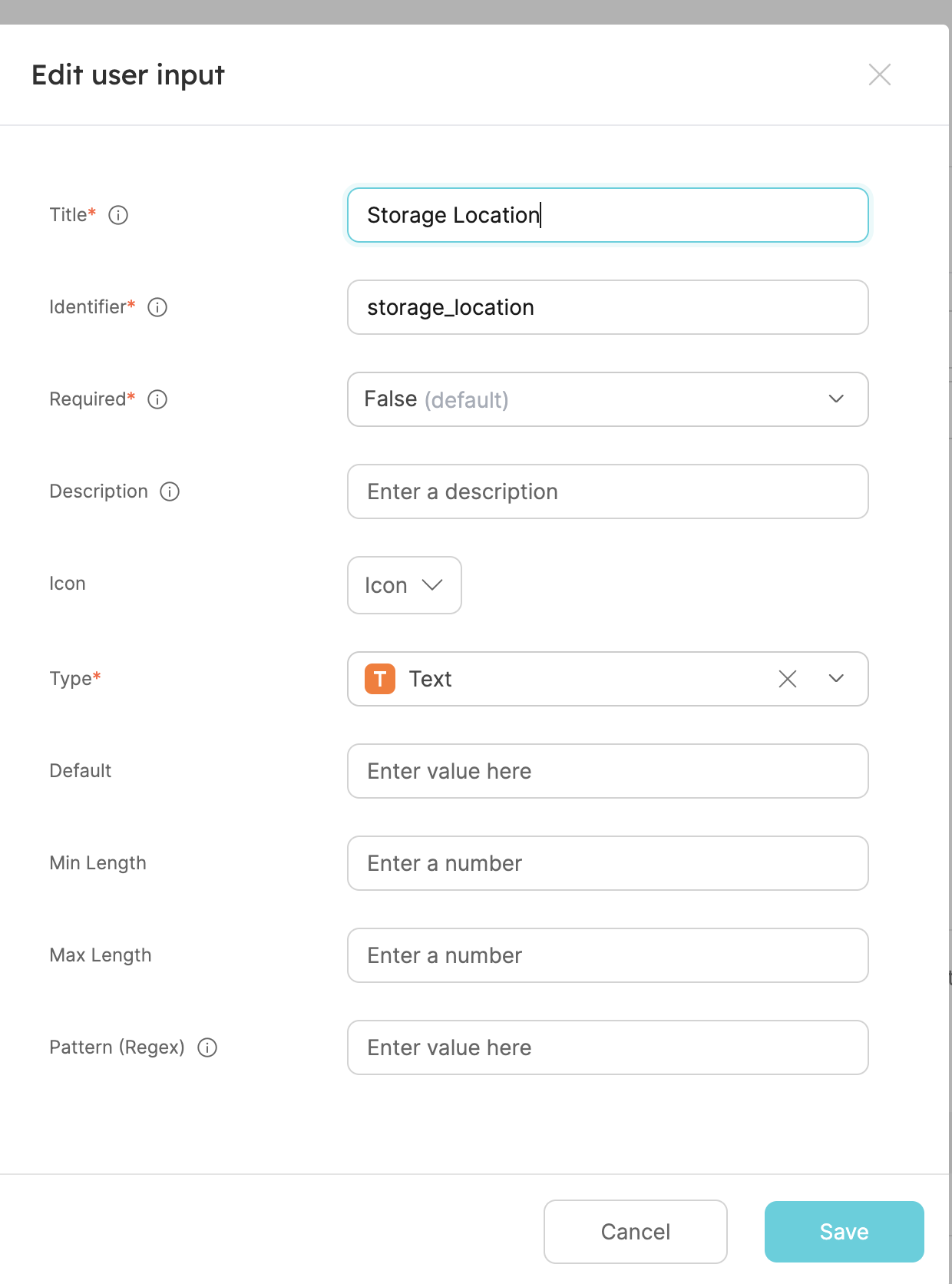
- Now we'll define the backend of the action. Select the
Run Jenkins pipelineinvocation type.- Replace the
Webhook URLwith your jenkins job URL. - Make sure the URL is in the format
http://JENKINS_URL/generic-webhook-trigger/invoke?token=<JOB_TOKEN> - Click
Next:
- Replace the

Learn more about the Jenkins invocation type here.
- The last step is customizing the action's permissions. For simplicity's sake, we will use the default settings. For more information, see the permissions page. Click
Create.
The action's frontend is now ready 🥳
Setup the action's backend
Now we want to write the Jenkins pipeline that our action will trigger.
-
First, let's obtain the necessary token and secrets:
- Go to your GitHub tokens page, create a personal access token with
repoandadmin:orgscope, and copy it (this token is needed to create a pull-request from our pipeline).

-
To get your Port credentials, go to your Port application, click on the
...button in the top right corner, and selectCredentials. Here you can view and copy yourCLIENT_IDandCLIENT_SECRET:
- Go to your GitHub tokens page, create a personal access token with
-
Create the following as Jenkins Credentials:
- Create the Port Credentials using the
Username with passwordkind and the idport-credentials.PORT_CLIENT_ID- Port Client ID.PORT_CLIENT_SECRET- Port Client Secret.
WEBHOOK_TOKEN- The webhook token so that the job can only be triggered if that token is supplied.GITHUB_TOKEN- The personal access token obtained from the previous step.
- Create the Port Credentials using the
-
We will now create a simple
.tffile that will serve as a template for our new resource:
- In your GitHub repository, create a file named
create-azure-storage.tfunder/templates/(it's path should be/templates/create-azure-storage.tf). - Copy the following snippet and paste it in the file's contents:
create-azure-storage.tf
resource "azurerm_storage_account" "storage_account" {
name = "{{ storage_name }}"
resource_group_name = "YourResourcesGroup" # replace this with one of your resource groups in your azure cloud account
location = "{{ storage_location }}"
account_tier = "Standard"
account_replication_type = "LRS"
account_kind = "StorageV2"
}
Add the main.tf file in the root of your repository.
main.tf
# Configure the Azure provider
terraform {
required_providers {
azurerm = {
source = "hashicorp/azurerm"
version = "~> 3.0.2"
}
}
required_version = ">= 1.1.0"
}
provider "azurerm" {
features {}
}
-
Now let's create the pipeline file:
- Enable webhook trigger for a pipeline
- Define variables for a pipeline: Define the STORAGE_NAME, STORAGE_LOCATION, REPO_URL and PORT_RUN_ID variables.
- Token Setup: Define the token to match
JOB_TOKENas configured in your Port Action.
Our pipeline will consist of 3 steps for the selected service's repository:
- Adding a resource block to the
main.tfusing the template and replacing its variables with the data from the action's input. - Creating a pull request in the repository to add the new resource.
- Reporting & logging the action result back to Port.
In your Jenkins pipeline, use the following snippet as its content:
Jenkins pipeline
import groovy.json.JsonSlurper
pipeline {
agent any
environment {
GITHUB_TOKEN = credentials("GITHUB_TOKEN")
NEW_BRANCH_PREFIX = 'infra/new-resource'
NEW_BRANCH_NAME = "${NEW_BRANCH_PREFIX}-${STORAGE_NAME}"
TEMPLATE_FILE = "templates/create-azure-storage.tf"
PORT_ACCESS_TOKEN = ""
REPO = ""
}
triggers {
GenericTrigger(
genericVariables: [
[key: 'STORAGE_NAME', value: '$.payload.properties.storage_name'],
[key: 'STORAGE_LOCATION', value: '$.payload.properties.storage_location'],
[key: 'REPO_URL', value: '$.payload.entity.properties.url'],
[key: 'PORT_RUN_ID', value: '$.context.runId']
],
causeString: 'Triggered by Port',
allowSeveralTriggersPerBuild: true,
regexpFilterExpression: '',
regexpFilterText: '',
printContributedVariables: true,
printPostContent: true
)
}
stages {
stage('Checkout') {
steps {
script {
def path = REPO_URL.substring(REPO_URL.indexOf("/") + 1);
def pathUrl = path.replace("/github.com/", "");
REPO = pathUrl
}
git branch: 'main', credentialsId: 'github', url: "git@github.com:${REPO}.git"
}
}
stage('Make Changes') {
steps {
script {
sh """cat ${TEMPLATE_FILE} | sed "s/{{ storage_name }}/${STORAGE_NAME}/g; s/{{ storage_location }}/${STORAGE_LOCATION}/g" >> main.tf"""
}
}
}
stage('Create Branch and Commit') {
steps {
script {
sh "git checkout -b ${NEW_BRANCH_NAME}"
sh "git commit -am 'Add a new resource block file'"
sh "git push origin ${NEW_BRANCH_NAME}"
}
}
}
stage('Create pull request') {
steps {
script {
repo = REPO
branch_name = NEW_BRANCH_NAME
base_branch = 'main'
title = 'New resource block ' + STORAGE_NAME
body = 'This pull request adds a new resource block to the project.'
createPullRequestCurl(repo, branch_name, base_branch, title, body)
}
}
}
stage('Get access token') {
steps {
withCredentials([usernamePassword(
credentialsId: 'port-credentials',
usernameVariable: 'PORT_CLIENT_ID',
passwordVariable: 'PORT_CLIENT_SECRET')]) {
script {
// Execute the curl command and capture the output
def result = sh(returnStdout: true, script: """
accessTokenPayload=\$(curl -X POST \
-H "Content-Type: application/json" \
-d '{"clientId": "${PORT_CLIENT_ID}", "clientSecret": "${PORT_CLIENT_SECRET}"}' \
-s "https://api.getport.io/v1/auth/access_token")
echo \$accessTokenPayload
""")
// Parse the JSON response using JsonSlurper
def jsonSlurper = new JsonSlurper()
def payloadJson = jsonSlurper.parseText(result.trim())
// Access the desired data from the payload
PORT_ACCESS_TOKEN = payloadJson.accessToken
}
}
}
}
stage('Notify Port') {
steps {
script {
def logs_report_response = sh(script: """
curl -X POST \
-H "Content-Type: application/json" \
-H "Authorization: Bearer ${PORT_ACCESS_TOKEN}" \
-d '{"message": "Created GitHub PR for new terraform resource ${STORAGE_NAME}"}"}' \
"https://api.getport.io/v1/actions/runs/$PORT_RUN_ID/logs"
""", returnStdout: true)
println(logs_report_response)
}
}
}
stage('Update Run Status') {
steps {
script {
def status_report_response = sh(script: """
curl -X PATCH \
-H "Content-Type: application/json" \
-H "Authorization: Bearer ${PORT_ACCESS_TOKEN}" \
-d '{"status":"SUCCESS", "message": {"run_status": "Jenkins CI/CD Run completed successfully!"}}' \
"https://api.getport.io/v1/actions/runs/${PORT_RUN_ID}"
""", returnStdout: true)
println(status_report_response)
}
}
}
}
post {
failure {
// Update Port Run failed.
script {
def status_report_response = sh(script: """
curl -X PATCH \
-H "Content-Type: application/json" \
-H "Authorization: Bearer ${PORT_ACCESS_TOKEN}" \
-d '{"status":"FAILURE", "message": {"run_status": "Failed to create azure resource ${STORAGE_NAME}"}}' \
"https://api.getport.io/v1/actions/runs/${PORT_RUN_ID}"
""", returnStdout: true)
println(status_report_response)
}
}
// Clean after build
always {
cleanWs(cleanWhenNotBuilt: false,
deleteDirs: true,
disableDeferredWipeout: false,
notFailBuild: true,
patterns: [[pattern: '.gitignore', type: 'INCLUDE'],
[pattern: '.propsfile', type: 'EXCLUDE']])
}
}
}
def createPullRequestCurl(repo, headBranch, baseBranch, title, body) {
curlCommand = "curl -X POST https://api.github.com/repos/$repo/pulls -H 'Authorization: Bearer ${GITHUB_TOKEN}' -d '{ \"head\": \"$headBranch\", \"base\": \"$baseBranch\", \"title\": \"$title\", \"body\": \"$body\", \"draft\": false }'"
try {
response = sh(script: curlCommand)
if (response.contains('201 Created')) {
println "Pull request created successfully"
} else {
println "Failed to create pull request"
println response
}
} catch (Exception e) {
println "Error occurred during CURL request: ${e.getMessage()}"
}
}
All done! The action is ready to be executed 🚀
Execute the action
After creating an action, it will appear under the Self-service tab of your Port application:
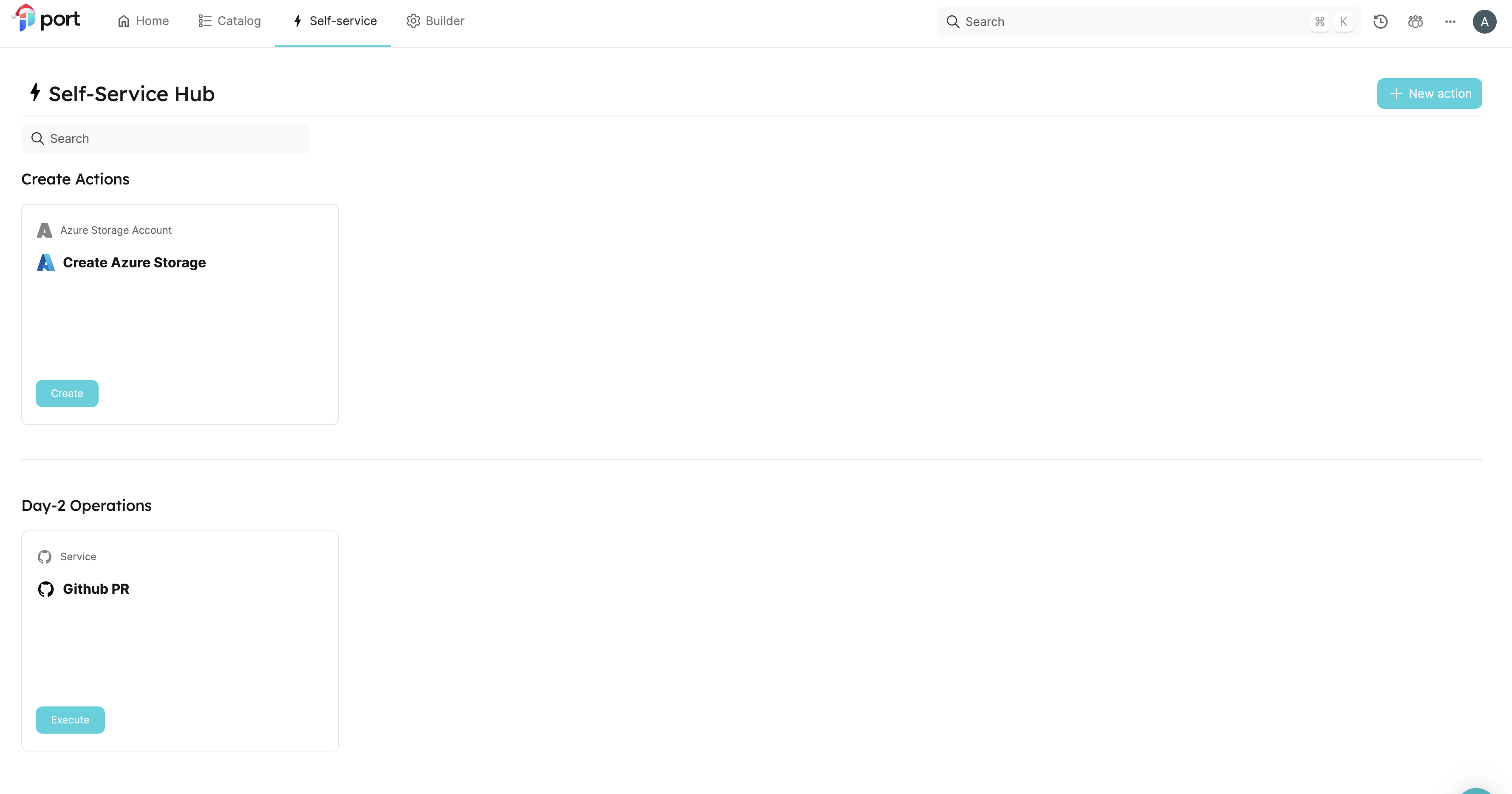
-
Click on
Execute. -
Enter a name for your Azure storage account and a location, select any service from the list and click
Execute. A small popup will appear, click onView details:
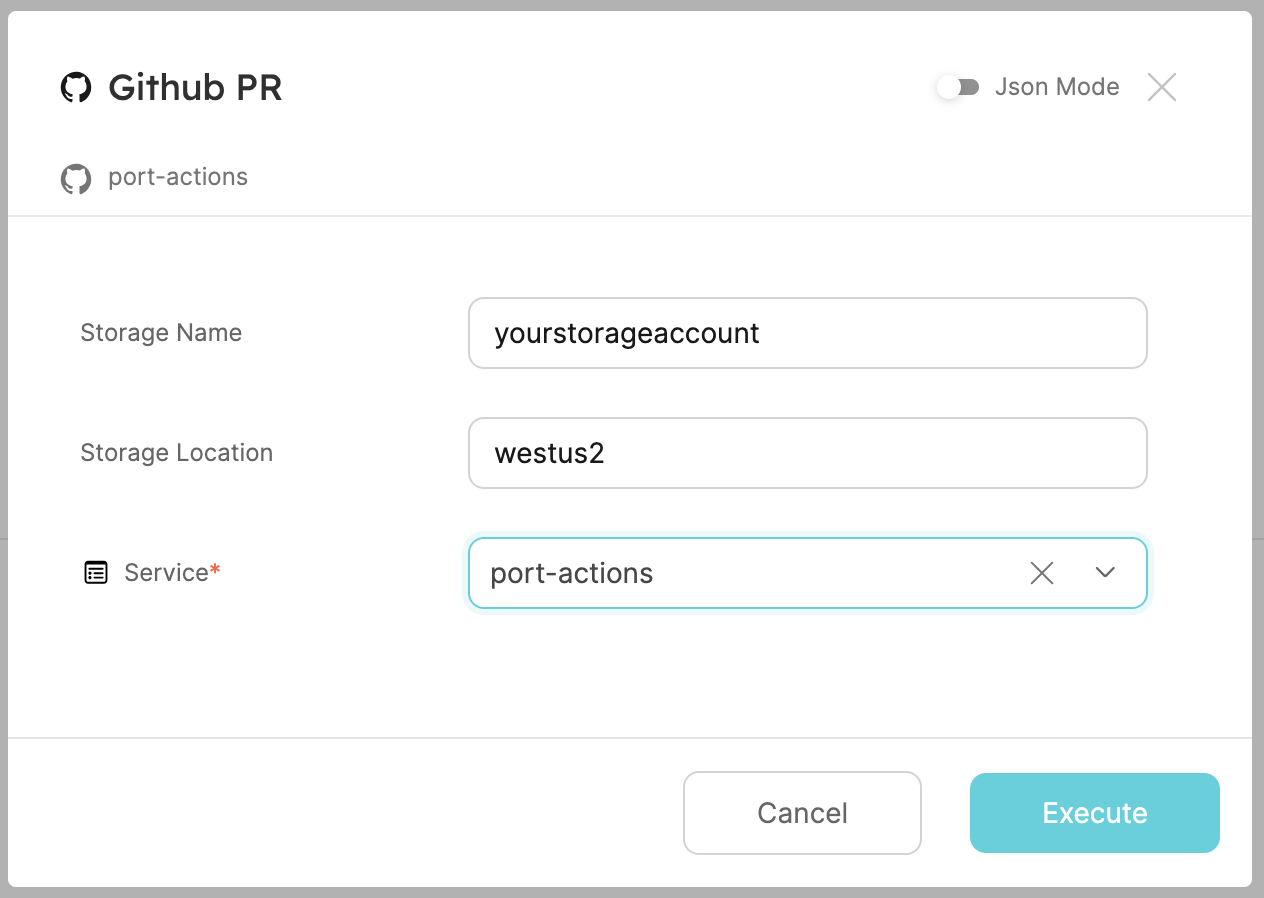

- This page provides details about the action run. We can see that the backend returned
Successand the pull-request was created successfully:
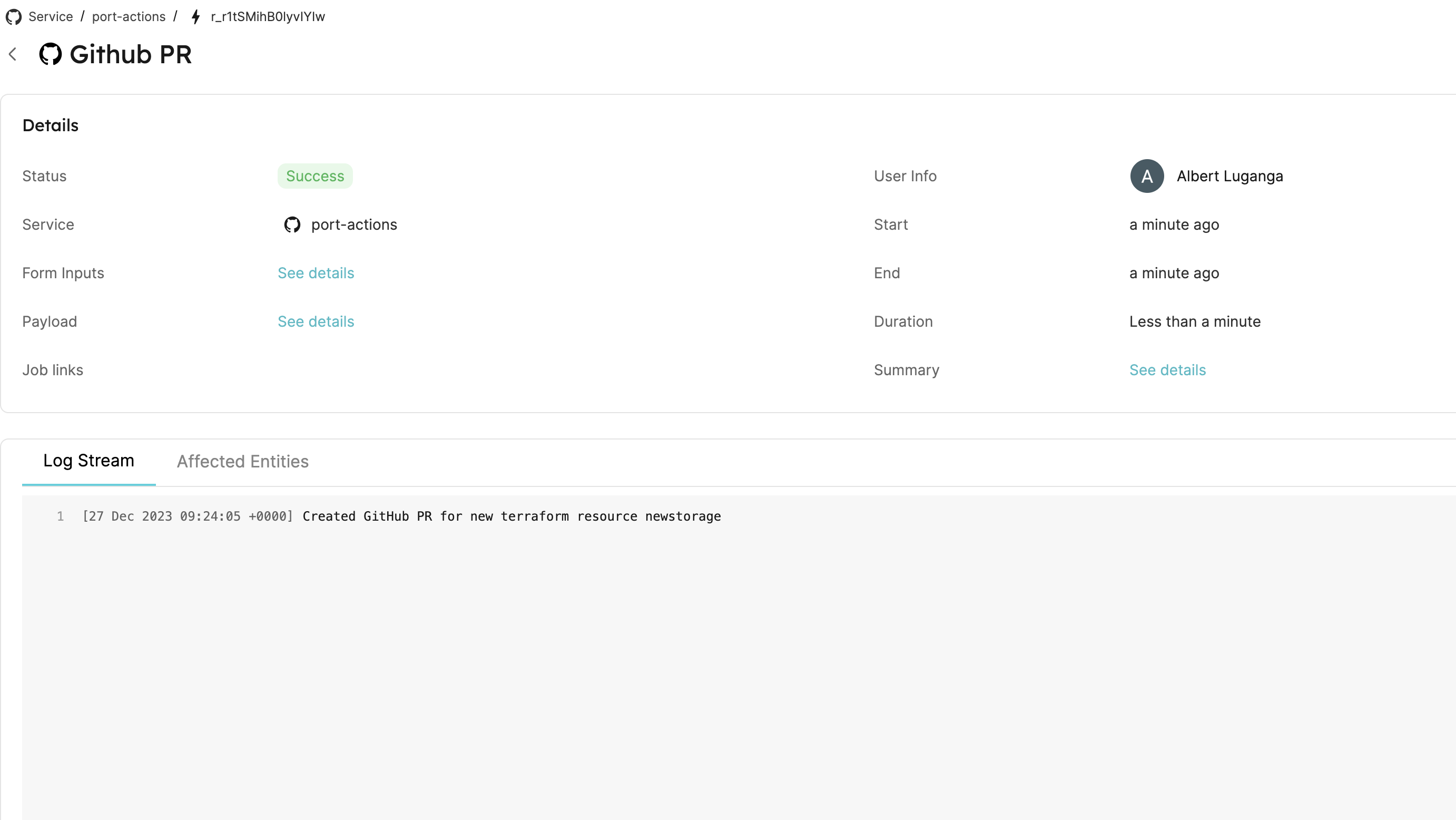
All done! You can now create PRs for your services directly from Port 💪🏽
You may create a Jenkins pipeline to trigger the resource deployment on merging the PR. Checkout this example pipeline.
More relevant guides and examples: